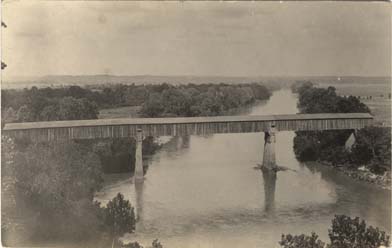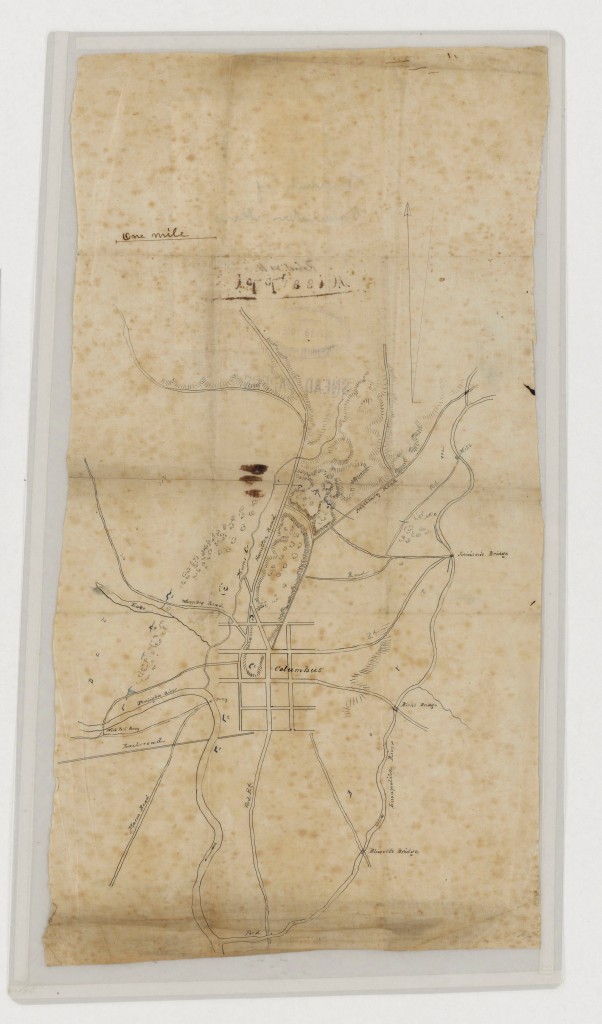
Note: Item has been updated March 1, 2022 with additional information about Edmund and Susan King
An item on The Bridgehunter’s Chronicles last week led me to explore more about the southern bridge builder, Horace King. The Encyclopedia of Alabama entry puts his birth as 1807, in the Chesterfield district of South Carolina, born into slavery and of mixed African, European, and Catawba ancestry. FamilySearch information lists his parents as Edmund R. King and his mother as Susan King, but there is no record of marriage, nor supporting documents. His mother was enslaved also, and this may have accounted for their last names as it was customary during the period. However, the Rev. F. L. Cherry (The history of Opelika and her agricultural tributary territory, Oct. 19, 1883, p. 6) reported the details of Horace King’s birth obtained by an interview. Cherry reported that the remnant of Catawba Indians in Cheraw District formed intermarriage with some enslaved women, including one who married a woman “belonging to a branch of the King family…from this marriage sprang a family of Creoles, who were born in bondage. One of those Creole slaves was the mother of Horace King, a name and character well known throughout Georgia and Alabama as associated with honor and integrity” (p. 6). Cherry also identified the father as Edmund King, also among the King family enslaved. (See entry on Edmund and Susan King for additional detail about the origins and ethnicity of Horace King and his parents.)
When Edward King (Horace and Susan’s original ‘master’) died, they were purchased by John Jennings Dunlap and subsequently, to John Godwin.
Godwin and King had learned to build covered bridges using the Town Lattice Truss design developed by Ithiel Town of Connecticut. Godwin had submitted a bid to construct a bridge over the Chattahoochee River at Columbus, Georgia. It was accepted and the Milledgeville Georgia Journal ran an ad July 19, 1832 for stone masons to construct the piers of the bridge. Their bridge building reputation took off from there. In 1846, with the assistance of an Alabama legislator, Robert Jemison, Jr., Horace King was granted his freedom. Because his wife had been a free woman of color, their children were born free. King’s reputation as a skilled bridge builder and reputable man had enabled him through his work with Godwin to travel freely throughout the south, even prior to his gaining manumission. King built 3 bridges for Jemison in Mississippi in 1845, which likely held some influence in the process of his freedom.

What piqued my interest was a newspaper item that indicated King also built bridges in Northeast Mississippi, so I started down the path to figure out when and where. In the days when Preservation in Mississippi occupied much of my free time, I would have seized the opportunity to report on his Mississippi work. Newspaper archives gave me clues as to location, and the amazing Historic Resources Inventory database for the Mississippi Department of Archives and History helped fill in details, as did other historic records. What follows is the account I can piece together of King’s work in Mississippi, based on his work using the Town lattice truss system.

King’s work in Georgia, Alabama, and Mississippi was prolific, and in addition to bridges, he constructed houses and large edifices, such as courthouses. Numerous books and articles have been written about his work, and I cannot do it justice in a single post. Nonetheless, I was pleased to discover his success and fame prior to, during, and after the Civil War. It seemed like an excellent time during Black History Month to acknowledge at least his Mississippi work, which is perhaps lesser known as there is less coverage on it—at least, that I could find.
Mississippi Department of Archives and History, Historic Resources Inventory database identified the non-extant bridge as the Tombigbee River Bridge of 1840s, located at Bridge Street/4th Avenue South. Construction date was estimated at 1842-1844, which is consistent with newspaper records about the bridge during the years 1836 when proposed construction of the bridge was announced by the Jackson Southern Argus, and for its completion in the Southern Reformer (Jackson, MS, Nov 12, 1843, p. 3) “by a colored [sic] architect.” John Godwin and Horace King are attributed as builder/contractor. Additionally, other newspaper items from the time of King’s work praised his bridges and identified locations. For example:
Horace King, the celebrated bridge-builder, and one of the foremost colored men in the State, who has concluded a contract to build the bridges that may be required on the Montgomery Southern Railway, is prospecting in the country to secure suitable lumber for the purpose…The bridge over the Chattahoochee, at Columbus, Ga., and that of the Mobile & Ohio branch railroad, over the Bigbee river, at Columbus, Miss., and others that could be named, are worthy monuments of his skill, and the durability of his work. Had he been educated for that profession, he would have been one of the most successful of civil engineers.
The Weekly Advertiser, Montgomery, Alabama, July 12, 1881, p. 3
There are no photographs of the Columbus covered bridge in public domain, but in 2017, Rufus Ward (Ask Rufus: Horace King and the 1842 Tombigbee bridge) featured a drawing of the bridge by Sam Kaye using period descriptions. It matches the other Town Lattice Truss bridges constructed by King, such as the Dillingham Street Bridge and the Eufala bridge over the Chattahoochee in Alabama, as well as the Steens bridge in Mississippi.


In addition to the Columbus bridge, King built at least 3 covered bridges in Lowndes County for Robert Jemison, Jr. Jemison owned a sawmill and grist meal on the Luxapalila Creek and Yellow Creek tributary and bridges were needed to enable access to the mills. Photographs of one of the bridges are archived in the Library of Congress, thanks to the 1936 Historic American Building and Engineer Record surveys. It is identified as the Town lattice truss bridge, which was the type of bridge built by Horace King. Credits: Historic American Buildings Survey, James Butters, Photographer, June 12, 1936 Underneath East Entrance, Old Covered Bridge, Steens, Lowndes County MS, Library of Congress. Historic American Buildings Survey, James Butters, Photographer, June 12, 1936 Detail West Entrance, Old Covered Bridge, Steens, Lowndes County MS, Library of Congress.
A map of the location of the bridges as described in ca. 1864 is in the National Archives.

Although none of Horace King’s bridges survive in Mississippi, there are 2 examples in Georgia attributed to King or to his sons, who carried on the family business.
*John S. Lupold, Columbus State University & Thomas L. French, French & Associates, Columbus, Georgia, Horace King. Encyclopedia of Alabama. Retrieved from http://encyclopediaofalabama.org/article/h-1245






Amazing accomplishments by Horace King! I didn’t know he built so many bridges in other States outside of Georgia. Thank you very much for this wonderful tribute and informative posting for Black History month. Best Regards.
LikeLike
I am glad you appreciated the post, Joyce, and thank you for your comment. I thought his accomplishments were indeed amazing and once I knew about him, just had to add to the story.
LikeLike
Great post for black history month. Covered bridges are beautiful works of art. It has been a long time since I have been anywhere near a covered bridge. Glad Horace King finally gained his freedom and his sons carried on his legacy as a bridge builder.
LikeLiked by 1 person
Thank you, Peggy. They did indeed leave a legacy, and one of the son’s bridges just returned “home” earlier this month.
LikeLiked by 1 person
He was certainly a prolific builder. You said there are examples of his bridges in Alabama and Georgia – are any of those in existence today? My sister lives on “Lowndes” street. I Googled the name when I read it in your post. Thank you for educating me about Horace King. It seems he should be featured in a museum somewhere…
LikeLiked by 1 person
Betty, I need to correct the statement about bridges remaining in Alabama. There are no extant bridges of King’s in Alabama.
LikeLiked by 1 person
Your investigative work is still quite impressive.
LikeLiked by 1 person
Thanks–I do my best.
LikeLiked by 1 person
He is credited with the Red Oak Creek covered bridge in Georgia, but some accounts suggest it could have been built by one of his sons. The LaGrange bridge recently returned home to LaGrange, and accounts differ as to whether it was Horace or his son George who constructed it. His portrait and a marker are in the Alabama capitol building, which he worked on. The LaGrange Art Museum contains a replica on one of his bridges, and there are numerous markers and tributes to him in Georgia.
LikeLike
What a wonderful story, and so perfect to round out Black History Month. Thank you so much for sharing this.
LikeLiked by 1 person
Thank you, Dorothy. It was a fascinating research project.
LikeLiked by 1 person
Fascinating. I love covered bridges. The design makes sense because the roof protects the decking from rain, ice, and snow. It’s a pity none of his bridges are left in Mississippi.
LikeLiked by 1 person
Yes, it is. I was surprised to find one lasted until 1936 though, and at least there are photographs!
LikeLike
Pingback: Tribute to Black History: Horace King, “the most respected bridge-builder in Alabama, Georgia, and northeastern Mississippi during the mid-nineteenth century”* — Suzassippi’s Lottabusha County Chronicles – The Bridgehunter's Chronic
Pingback: Tribute to Black History: Horace King, “the most respected bridge-builder in Alabama, Georgia, and northeastern Mississippi during the mid-nineteenth… – Kobcountrymusic